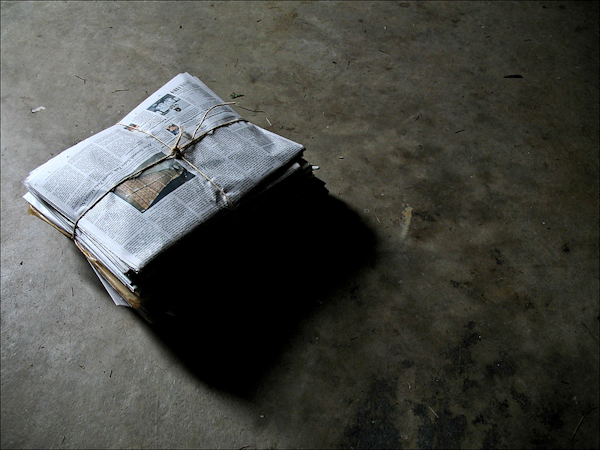SEJournal Online is the digital news magazine of the Society of Environmental Journalists. Learn more about SEJournal Online, including submission, subscription and advertising information.
 |
 |
| Decline in the local newspaper business has left a vacuum for fake papers to emerge, and that’s bad news for environment reporting, says WatchDog Opinion. Photo: Keith Jenkins, courtesy Flickr Creative Commons (CC BY-NC-ND 2.0 DEED). |
WatchDog Opinion: Fake Newspapers Fill Gaps Left by Disappearing Real Ones
By Joseph A. Davis
Just as hundreds of local newspapers are going bankrupt and folding, hoaxers are filling the gap with fake newspapers.
Sometimes the hoaxers are environmental bad guys. Normally, we would avoid calling anyone a “bad guy” — but we think this kind of deception justifies it. Good guys aren’t liars.
One example is the Richmond Standard in the San Francisco Bay area — it’s owned by the Chevron Corp. Miranda Green of Floodlight and David Folkenflik of NPR wrote about it recently. The bottom line: “Many stories aren’t told.”
Another is the story of how Alabama Power bought a Black newspaper and financed a news service to ensure a steady flow of utility-friendly stories and slime the company’s political adversaries.
This development in the annals of “fake news” is not new. But it is worsening quickly because of the destructive churn that is sapping the news industry.
Rise of ‘pink slime journalism’
A few years ago, the Columbia Journalism Review did a four-part series on the fake newspaper phenomenon. The series, authored by Priyanjana Bengani, built on research by Columbia’s Tow Center for Digital Journalism.
The Tow study ultimately identified
some 1,200 outlets with names
that sounded like legitimate
newspapers (but weren’t).
By turning over rocks methodically, the Tow study ultimately identified some 1,200 outlets with names that sounded like legitimate newspapers (but weren’t). Many were purveyed by an organization calling itself Metric Media. There were others.
Tow found that much of the content came from far-right groups trying to influence the 2020 election. Funding for the operations, CJR found, came from “dark money groups.” Much of it could be traced back to conservative businessman Brian Timpone (may require subscription). This network of networks, according to CJR, had come to be called “pink slime journalism.”
A significant part of this publishing grift, we now see, has focused on environmental and energy issues. That worries the WatchDog.
Decline of local news
All this comes during an era when real local newspapers — i.e., legitimate ones — are dropping like flies, as the economics and technology of the industry change.
Don’t take our word for it. The Medill School of Journalism at Northwestern University found that more than half of U.S. counties have no access or very limited access to local news. This is a longer-term trend and there are many reasons for it. But the decline of local news is worrying not just us, but many in the journalism world generally. And some visionary pioneers have already begun trying to fix it.
The decline in real local
journalism has hurt
the environment beat
more than others.
Many important environmental and energy issues actually are local or regional, and the decline in real local journalism has hurt the environment beat more than others.
Making it worse: financial hardship keeps many outlets from dedicating a beat just to the environment. General assignment reporters may lack the expertise to cover the obscure technical and legal issues before, say, a public service commission.
If you want to dig deeper, you may find help from this list of fake newspapers and news outlets. Or this one.
What’s needed? More skepticism, more newsrooms
There are tricks and techniques for recognizing fake news outlets. A healthy skepticism is a good start. Evaluate the source.
University libraries, which are journalists’ allies, have a lot of advice about how to sift out fake news outlets. See this advice from the Bethel College Library. Or these tips from the Cornell Library. Here are more from Central Washington University. Or the University of Michigan’s Mardigian Library.
Part of the cure is
more and better
local newsrooms.
Part of the cure is also more and better local newsrooms. For example, look at Medill’s Local News Initiative. The Associated Press is giving local outlets technical support via its Local News AI initiative.
The Knight Foundation has been spending its serious megabucks on nurturing local news, as well. Knight’s behemoth American Journalism Project raises significant funding for local newsrooms. The nonprofit Local Journalism Project gets funding from a wide variety of private (but disclosed) donors. One of the strongest efforts is ProPublica’s Local Reporting Network, which partners with local newsrooms on investigative and accountability projects.
Ultimately, it must be said: A lot of the decline comes from the for-profit business model. Go ahead, blame it on hedge funds and “vulture capitalism” (looking at you, Gannett). One part of the solution to fake newspapers, we think, is (funded) nonprofit journalism.
[Editor’s Note: See other recent WatchDog Opinion columns on press freedom issues, including on whether AI will make it easier to limit press freedom, prospects for press freedom in a potential second Trump administration, problems with the corporate business model and more.]
Joseph A. Davis is a freelance writer/editor in Washington, D.C. who has been writing about the environment since 1976. He writes SEJournal Online's TipSheet, Reporter's Toolbox and Issue Backgrounder, and curates SEJ's weekday news headlines service EJToday and @EJTodayNews. Davis also directs SEJ's Freedom of Information Project and writes the WatchDog opinion column.
* From the weekly news magazine SEJournal Online, Vol. 9, No. 21. Content from each new issue of SEJournal Online is available to the public via the SEJournal Online main page. Subscribe to the e-newsletter here. And see past issues of the SEJournal archived here.












 Advertisement
Advertisement 



